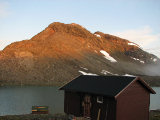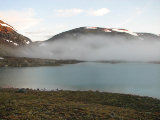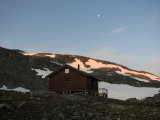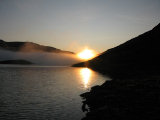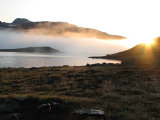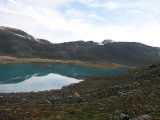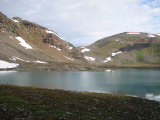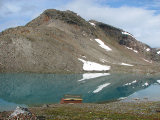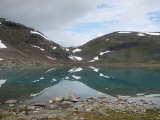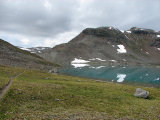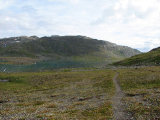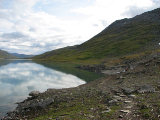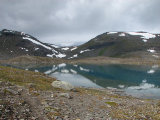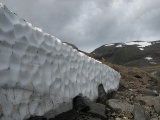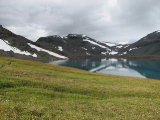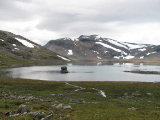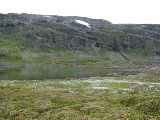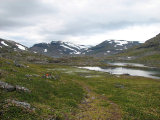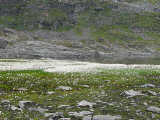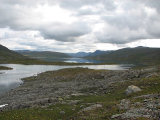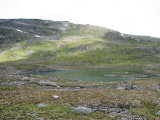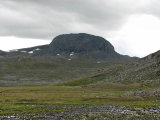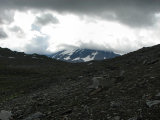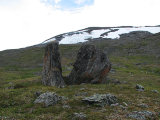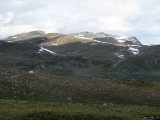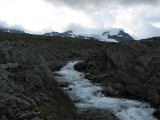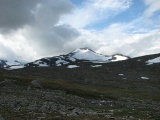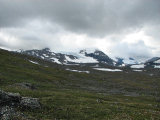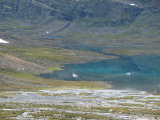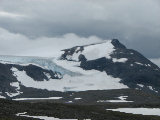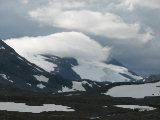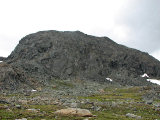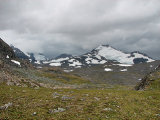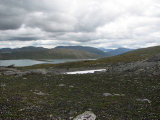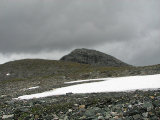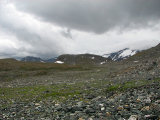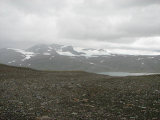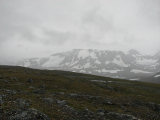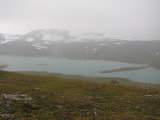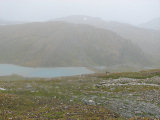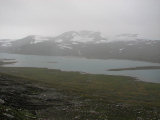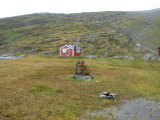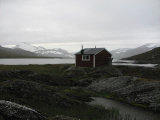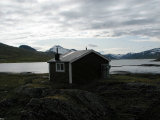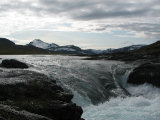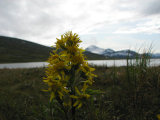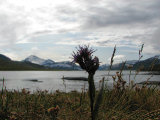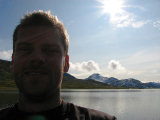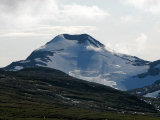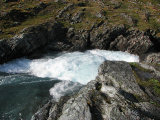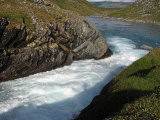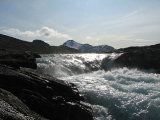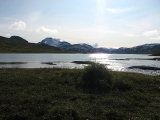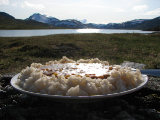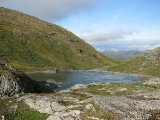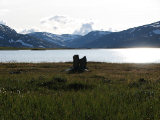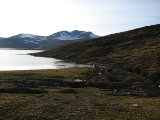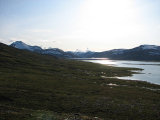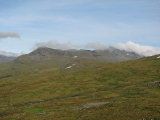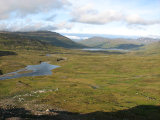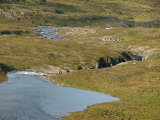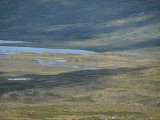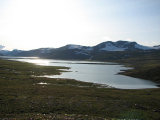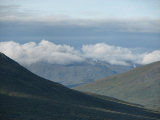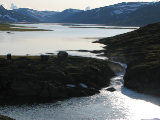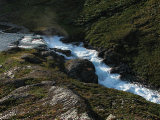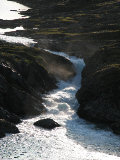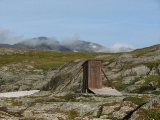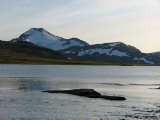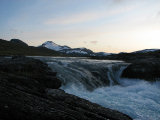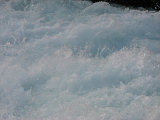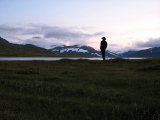Monday 10/8

Sorjushytta – Sårjåsjaure (via Stáddátjåhkkå)
| Horizontal distance: | 14 km |
| Vertical distance: | +360 m, -380 m |
| Time: | 6 h |
| Lunch break: | 45 min |
| Dinner: | Rice with tandoori sauce |
| Night accommodation: | Cottage |
| Stage classification: | Medium (comment)
This rating is due to the outbreak of severe weather; the terrain as such was very easy for the most part.
|
| Map points: | Sorjushyttene, Sårjåsjaure |
Save for some snore-disturbances I slept well until around 5, when I went out to take a leak. The sky was still clear, there was a warm light in the higher regions, and across the lake a bank of fog stretched out to complete the scene. I stood at the shore and waited for the sunrise, and was rewarded by a beautiful light show when the first rays pierced the mists. Back in bed I had trouble getting back to sleep, but I eventually I managed and woke up at 7 next time, dozing on and off until 08:00.
The quartet was having breakfast and once they were finished I did the same, watching the New Zealander go up the snowfield, make his way around the crack and thus over the stream, and then proceed along the shore in the direction of Blåmannsisvatnet. Now there were a bit of clouds but things still seemed good, even though dark shades in the west instilled some worry. As the group packed up and cleaned, however, the sky cleared once more starting from the west, so it looked like it was going to be a great day. I finished up myself and talked a bit with the others and the warden outside, and we went our respective ways at 09:45.
As I left it had grown darker behind me again, and the sun was hidden behind a fresh set of clouds, but the weather was perfect for hiking. For a bit the trail was rather wet and there were some insects to fend off, but then it got better. The darkness behind also lightened again, and I found the landscape desperately beautiful with grassy slopes gently slanting into the teal-colored water, with steep bare rock on the far side. I passed some grunting reindeer – the tour's first – as well as a few wet patches, and then saw a siejdde out in the lake – a stone formation that in the old Sámi tradition was the abode of natural spirits and therefore holy.
It was getting a bit warm, and I was therefore glad for the arrival of a pleasant wind after the long bumpy turn past the connection between Bajep Sårjåsjávrre and Sårjåsjávrre proper (called Vuolep Sårjåsjávrre by the Norwegians, to match). Svarthammaren (just Hammaren on Swedish maps) was now a looming presence, and soon I was in a position to see Sulidälbmá again, but the clouds had grown numerous and dense enough to cut the massif in half. Earlier this stage involved a ford of the stream from the glacier beneath Kokedaltinden, which could be a problem at times, but since a few years back there is a fixed bridge about half a kilometer upstream, courtesy of the Norwegians. Since it is so new, however, it does not appear on all maps, and neither is it visible down from the old ford, but at least from this direction there was a clear sign and trail markers turning upwards.
Now, the ford seemed easy enough at the moment, divided into many courses as it is, but I still elected to check out the bridge. Due to the freshness this connection trail had no discernable path, but the markers led the way well, and should they not have it would have been a simple matter of following the stream. The bridge gave a robust impression even though it swung pretty much as I walked over it, and up here the stream is more impressive. On the other side I left the trail at once and headed straight up the slope, walking on nice grass and heath, until I found a good stone to sit against before 11:45.
I put on the fleece jacket but soon had to take it off again since it was rather warm, and the sun made a few visits too. I sat still for a while looking out over the visible parts of the massif and its glaciers, as well as the calm waters below, before digging into my lunch. The clouds covering the peaks of Sulidälbmá were slowly lifting, and I waited for them to leave entirely, which they did not do, but some good sights were offered. Another development was the advent of very dark clouds in the southwest, and rather than staying put to see what was to become of that I got going again, wanting to outrun it if at all possible.
I passed a small brook at once and found the rest of the slope easy, aiming between Svarthammaren and a low rise north of it. When I reached the crest some drops started falling, but after a short while of greater density they stopped doing so. Somewhere here I passed the national border (which was as it should be: invisible) and then I turned slightly right, passing over a bumpy rise while all the time it was growing darker behind Svarthammaren. When I had come far enough to see Sulidälbmá again the Swedish Stortoppen was covered by a thick cloud, and north of Sårjåsjávrre a peak cap was also forming. My reasoning for taking this route rather than sticking to the trail beside the lake was that the view from Stáddátjåhkkå is hailed as matchless for its perfect panorama perspective of the Sulidälbmá massif, and now I directed my steps right at the summit.
The terrain was mostly flat at first, but later turned furrowed, and now the drops had returned. This time they did not stop, and when the veil of rain pulled in over the lake I stopped to put on the rain jacket and the rain cover. A wind had also picked up, and I stood beside the largest stone I could find to save the trousers from the worst of the wetness. In short fashion a thick fog covered the western end of the lake valley as well as the massif – and suddenly lightning struck somewhere among the southern peaks! Instinctively I counted the seconds and estimated the distance to about 6 km – and just as instinctively I was alarmed to find myself so exposed. Thus I walked briskly in a cowering manner to a larger rock a hundred or so meters further ahead, and then leaned against it in various ways, trying to balance shelter from the rain and wind with the desire not to be the highest point.
When it looked like the worst had passed I changed into a sitting position on the lee side, pulling my knees up to my chest, trying to let the rucksack and hat catch the rain. After a while this rain increased again, and then turned into a veritable downpour – and visibility dropped to zero. I sat in this way for quite some time with a somewhat detached outlook on my situation – sure, it was wet and uncomfortable, and had I been lost on a camping trip I may have felt in danger, but since I knew that a cabin lay just a few kilometers off below the slope off to my left I simply bided my time.
Then another flash struck, but due to the haze it only registered as a diffuse light, and this time the distance was about 3 km. The ensuing thunder roll came from the northeast, and now it appeared as though the worst of it was moving off in that direction, for behind my back visibility was improving. It was also raining less, and as I had grown tired of sitting still I got up – and nearly fell over, since my right foot had almost fallen asleep. I stood for a while, leaning into the wind, and was surprised to see that the peaks of Sulidälbmá were almost entirely visible through the haze.
I started walking downwards at an angle, taking short steps so as to minimize contact with the soaked trouser legs, and as usual it did not take long for the sensation of dampness to fade; that Climatic material of Haglöfs' is really something (no, I don't work there). I had only covered a short distance when I had a change of heart – there was only a drizzle now, and since the massif was so eminently showing I thought I might just as well continue the climb as I was already wet anyway. No more had I started doing so, however, than a cloud drifted up quickly from the lake, and I was enveloped in fog once more. I waited for a bit, and sure enough it soon started to lift and I started moving again. Another such sequence followed, after which it seemed to be getting better for real, and I moved at speed to some small hills closer to the southern edge of the plateau I was on, anxious not to miss the opportunity for a good view. This I did not, and I photographed as well I could while the rain tried to drench the lens.
Eventually I turned back, veering towards a marked "edge" in the terrain, after which followed an uneven descent that reminded me of the way down into the not too distant Viejevágge I had taken three years ago. Soon I saw the famed Konsul Perssons stuga at the eastern end of the lake, and all around except for the east visibility was getting better. I passed over many a small brook – none of which was marked on the map – and at length I came onto the wet trail just at the start of the beach (an actual beach), arriving at the tiny cabin before 15:45.
"Consul Persson" after whom the building is named was the owner of the Sulitjelma mines in the end of the 19th century, and it was his daughter, having fallen in love with this spot, who donated the funds to STF for a cabin to be constructed here – on the condition that it be named in her late father's honor. It was completed in 1922 and in recent years it has given a rather worn-down impression, but during the summer of 2008 a group of volunteers spent a week refurbishing the outside, so now it looks fine.
The inside still has a decidedly old look to it, but it is in good condition even though it is not very spacious. There are two small rooms with four beds in each, and I claimed the western one which not only is slightly larger, but also has a superb view of the lake, and started hanging up the wet stuff to dry. Unfortunately there was no firewood – STF does not provide it here – but a dry, sheltered place can do wonders. As it was, not much shelter was required any longer, for now the clouds were breaking up starting in the west, and the light was growing. I used the beach for a bath – a very cold one – and I also took the opportunity to wash my underwear. The rain had now stopped, and I could do naught but go on a photo round.
The cabin stands at the brink of a canyon into which the water of Sårjåsjávrre is pulled with force, creating a small but noisy and very beautiful lake fall, and across the lake stands the perfect shape of Sårjåstjåhkkå with its eternal ice. Many are those who view this as the prettiest place in the Swedish fjelds – the famous Swedish UN Secretary-General Dag Hammarskjöld being the most prominent one – or at least say that the cabin has one of the best locations.
Since it was now sunny again I hung the wet clothes outside instead, and then went to get a closer look at the lake fall and the gushing water below it, which merited some caution due to rocks' being wet both from rain and spray. I also participated in SM (Sårjås-Mästerskapen, the Sårjås Championships) – a contest announced on a piece of paper on one of the inside doors, with the object of getting as many bounces as possible with ten flat stones thrown from the shore – and reached 51, which placed me second among those who had recorded their results thus far.
Then it was time for dinner, and of choices other than to eat it outside there were none. Now the persistent clouds in the east were also breaking apart, but the peaks there still hung on to them. After sitting at the shore for quite some time I washed up and went for an evening walk, wearing the sandals without socks. I followed the eastbound trail for a short bit, and it too was rather wet, so soon I left it and started climbing the slope up to a nearby hill. I mostly managed to stay dry, but the occasional damp step did not matter much what with my being barefoot.
As I got higher both the Staddajåkkå cottages and Jiegŋáffo came into view, and the latter retained its cloud grasp, as did Gáhpesoajvve and Álátjåhkkå in the distance. I stood at the top feeling absolutely terrific, enormously glad that the capricious weather had decided to grant me this extraordinary evening – a feeling strengthened in no small part by the preceding rough period. Such contrasts are commonplace in the fjelds, and do themselves in this way comprise much of their attraction. I surveyed the area with my binoculars and saw absolutely nothing but the grandness of nature, and not having run into anything but a few reindeer during the day the sense of personal kinship with said nature was fulfilled. Marvelous.
Finally I started descending again, going due north to the flattened crest of the rocky threshold that hides the lake (and the cabin) from the eastern valley. From here the view of the cabin beside the fall, with Sårjåsjávrre stretching out behind it and Sårjåstjåhkkå on the horizon was breathtaking, and I must join in the choir of praise for this place – if it's not the most beautifully located abode in the fjelds, it's right there at the top fighting for it. Consequently I could not move for a long while, but when I did I kept close to Sårjåsjåhkå, which involved a short climb past a small crevice after the snowfield that can be seen in one of the pictures below. This route brought me close to the privy, and looking back there I saw that the clouds were finally leaving Jiegŋáffo.
I relaxed inside for a while and then went out to a flat rock at the start of the beach to read, which I kept doing until the sun set. I took in the clothes for the night and made one of the (short) beds; it was actually quite warm in my room, whereas the unoccupied one was much cooler. I tried my hand at SM again a few times, but could not get anywhere near my previous top result, and then returned inside to go through the writings left there; among these was a collection of texts relating to last year's refurbishment and the cabin's history, which I eyed through.
Feeling the pull of the outdoors I exited again and sat by the fall for a good while, looking into the ever-changing shapes of the powerful water. This made me think of a poetic description of Stora Sjöfallet from the time before its demise, and once again I felt a deep sorrow for the terrible loss it was, even though I of course lack first-hand insight – but also thankful that places like this still do exist, where this kind of deep feeling can be experienced. Back inside I had my evening snack while reading in the book, and now some clouds coming from the north were amassing around the peaks to the west, which actually heightened the twilit beauty. Another such addition was the appearance of a veiled moon in the other direction, and it was very comfortable being outside, so it was many minutes before I could tear myself away from it. After reading some more it was a very contented hiker who crawled into bed at 22:30, with not too small a hope for another day like this.
